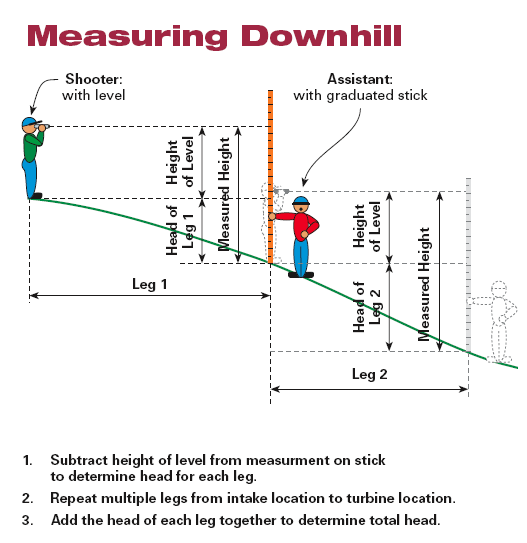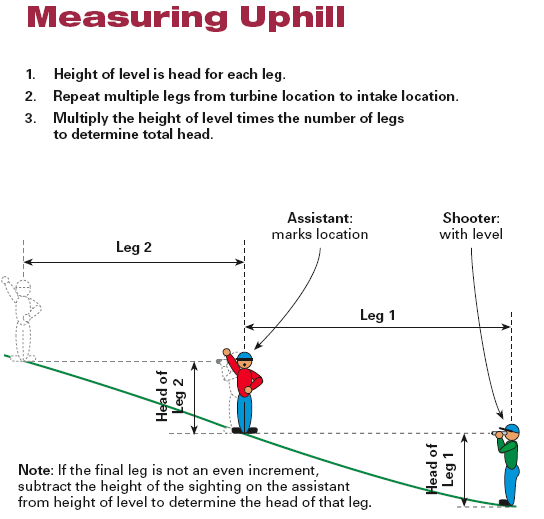Contents
Measuring WaterHead
What is a head of water? how to measure water head? WaterHead is water pressure, created by the difference in elevation between the intake of your pipeline and your water turbine. WaterHead can be measured as vertical distance (feet or meters) or as pressure (pounds per square inch, newtons per square meter, etc.). Regardless of the size of your stream, higher head will produce greater pressure—and therefore higher output—at the turbine.
An altimeter can be useful in estimating waterhead for preliminary site evaluation, but should not be used for the final measurement. It is quite common for low-cost barometric altimeters to reflect errors of 150 feet (46 m) or more, even when calibrated. GPS altimeters are often even less accurate. Topographic maps can also be used to give you a very rough idea of the vertical drop along a section of a stream’s course. But only two methods of waterhead measurement are accurate enough for hydro system design—direct height measurement and water pressure.
Direct Height Measurement
To measure waterhead, you can use a laser level, a surveyor’s transit, a contractor’s level on a tripod, or a sight level (“peashooter”). Direct measurement requires an assistant.
One method is to work downhill using a tall pole with graduated measurements. A measuring tape affixed to a 20-foot (6 m) section of PVC pipe works well. After each measurement, move the transit, or person with the sight level, to where the pole was, and begin again by moving the pole further downhill toward the generator site. Keep each transit or sight level setup exactly level, and make sure that the measuring pole is vertical. Take detailed notes of each measurement and the height of the level. Then, add up the series of measurements and subtract all of the level heights to find total waterhead.


Water Pressure Measurement
If the distance is short enough, you can use one or more garden hoses or lengths of flexible plastic tubing to measure head. This method relies on the constant that each vertical foot of head creates 0.433 psi of water pressure (10 vertical feet creates 4.33 psi). By measuring the pressure at the bottom of the hose, you can calculate the elevation change.
Run the hose (or tubing) from your proposed intake site to your proposed turbine location. If you attach multiple hoses together, make sure that each connection is tight and leak free. Attach an accurate pressure gauge to the bottom end of the hose, and completely fill the hose with water. Make sure that there are no high spots in the hose that could trap air. You can flush water through the hose before the gauge is connected to force out any air bubbles.
If necessary, you can measure total waterhead over longer distances by moving the hose and taking multiple readings. Keep in mind, however, that there is less than 1/2 psi difference for every vertical foot. Except for very steep hillsides, even a 100-foot hose may drop only a few vertical feet. The chance for error significantly increases with a series of low-waterhead readings. Use the longest possible hose, along with a highly accurate pressure gauge.
Computing Net WaterHead
By recording the measurements described in the previous sections, you have determined gross water head—the true vertical distance from intake to turbine, and the resulting pressure at the bottom. Net waterhead, on the other hand, is the pressure at the bottom of your pipeline when water is actually flowing to your turbine. This will always be less than the gross waterhead you measured, due to friction losses within the pipeline. You will need to have water flow figures (described in the following sections) to compute net waterhead. Longer pipelines, smaller diameters, and higher flows create greater friction. A properly designed pipeline will yield a net water head of 85 to 90 percent of the gross water head you measured.
Net waterhead is a far more useful measurement than gross head and, along with design flow, is used to determine hydro system components and electrical output. Here are the basics of determining pipe size and net head, but you should work with your turbine supplier to finalize your pipeline specifications.
Water Head loss refers to the loss of water power due to friction within the pipeline (also known as the penstock). Although a given pipe diameter may be sufficient to carry all of the design flow, the sides, joints, and bends of the pipe create drag as the water passes by, slowing it down. The effect is the same as lowering the head—less water pressure at the turbine.
WaterHead loss cannot be measured unless the water is flowing. A pressure gauge at the bottom of even the smallest pipe will read full psi when the water is static in the pipe. But as the water flows, the friction within the pipe reduces the velocity of the water coming out the bottom. Greater water flows increase friction further.
Larger pipes create less friction, delivering more power to the turbine. But larger pipelines are also more expensive, so there is invariably a trade-off between head loss and system cost. Size your pipe so that not more than 10 to 15 percent of the gross (total) head is lost as pipeline friction. Higher losses may be acceptable for high-head sites (100 feet plus), but pipeline friction losses should be minimized for most low-head sites.
The length of your pipeline has a major influence on both the cost and efficiency of your system. The measurement is easy,though.Simply run a tape measure between your intake and turbine locations,following the route you’ll use you’re your pipeline.Remember that you want to run the pipeline up out of the creek bed,when possible,to avoid damage during high water.

Read More on How to Measure WaterFlow?


